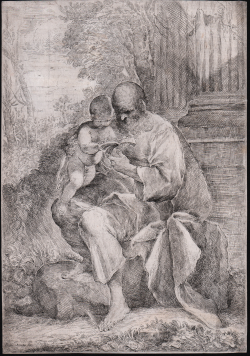




| Reference: | S47342 |
| Author | Francesco AMATO |
| Year: | 1650 ca. |
| Measures: | 185 x 265 mm |



| Reference: | S47342 |
| Author | Francesco AMATO |
| Year: | 1650 ca. |
| Measures: | 185 x 265 mm |
Saint Joseph teaches the Child Jesus to read, seated under a classical column.
Etching, circa 1650, signed lower left "Franc Amatus in".
A beautiful work, printed on contemporary laid paper, irregularly trimmed to the copperplate, in good condition.
Francesco Amato (born probably in Naples around 1590), was an etching engraver, active around 1650, according to Arthur M. Hind, who, like other scholars, places him in the Genoese circle of Giovanni Benedetto Castiglione and Bartolomeo Biscaino. Francesco Amato represents, in the framework of the so-called Genoese "picturesque" etching, a linguistic island, modest, but incomparable: he is frail and slow in hatching, often inconsistent, especially in modeling, and is best where he least insists on seeking it. Bartsch, who, after the reference of the ab. Zani and C. H. de Heinecken, analytically describes his work, assigns him five prints, two of which (St. Joseph with the Child Jesus on his knees, in a landscape with ruins, and St. Jerome sitting at the entrance of a cave, in the act of reading) clearly signed: "Franc. Amatus Inv.". The others are: a Holy Family with St. John the Baptist kissing the Child's foot, stylistically still very off-centre and contradictory, a Prodigal Son herding pigs and a St. Christopher on the river bank. In this last engraving, which is considered the masterpiece of the Amatus, he reveals his originality, not only stylistic, by giving a construct and an effective luminosity to his wicker hatching, but also inventive, by presenting the saint not as usual with the Child on his shoulders, but bent over him who is still sitting on the ground, with the globe in his hand, and in the act of inviting him to cross the river. Some authors attribute to him some other prints, but without foundation, especially when they confuse him with the so-called "Master A. F."..
A rare work.
Bibliografia
Bartsch, Le Peintre graveur (XXI.205.2); The Illustrated Bartsch 4719.354.002; Alfredo Petrucci, Dizionario Biografico degli Italiani - Volume 2 (1960); A. Petrucci, Un'acquaforte del Genovesino, in Idea, VII, 31, (1955), p. 3; Le Blanc C., Manuel de l'amateur d'estampes, 2, p. 34.
Francesco AMATO (1590 ca./ notizie fino al 1615)
|
Etcher, active around 1650, according to Arthur M. Hind. The latter, like other scholars, places him in the orbit of G. B. Castiglione and B. Biscaino; but in fact the A. represents, in the framework of the so-called "picturesque" Genoese etching, a linguistic island, modest, but incomparable: he is frail and slow in hatching, often inconsistent, especially in modeling, and is best where he least insists on seeking it.
|
Francesco AMATO (1590 ca./ notizie fino al 1615)
|
Etcher, active around 1650, according to Arthur M. Hind. The latter, like other scholars, places him in the orbit of G. B. Castiglione and B. Biscaino; but in fact the A. represents, in the framework of the so-called "picturesque" Genoese etching, a linguistic island, modest, but incomparable: he is frail and slow in hatching, often inconsistent, especially in modeling, and is best where he least insists on seeking it.
|